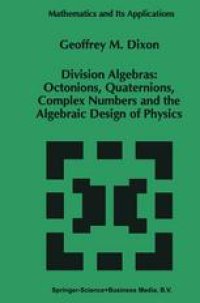
Ebook: Division Algebras: Octonions, Quaternions, Complex Numbers and the Algebraic Design of Physics
Author: Geoffrey M. Dixon (auth.)
- Tags: Applications of Mathematics, Non-associative Rings and Algebras, Nuclear Physics Heavy Ions Hadrons, Linear and Multilinear Algebras Matrix Theory
- Series: Mathematics and Its Applications 290
- Year: 1994
- Publisher: Springer US
- Edition: 1
- Language: English
- pdf
I don't know who Gigerenzer is, but he wrote something very clever that I saw quoted in a popular glossy magazine: "Evolution has tuned the way we think to frequencies of co-occurances, as with the hunter who remembers the area where he has had the most success killing game." This sanguine thought explains my obsession with the division algebras. Every effort I have ever made to connect them to physics - to the design of reality - has succeeded, with my expectations often surpassed. Doubtless this strong statement is colored by a selective memory, but the kind of game I sought, and still seek, seems to frowst about this particular watering hole in droves. I settled down there some years ago and have never feIt like Ieaving. This book is about the beasts I selected for attention (if you will, to ren der this metaphor politically correct, let's say I was a nature photographer), and the kind of tools I had to develop to get the kind of shots Iwanted (the tools that I found there were for my taste overly abstract and theoretical). Half of thisbook is about these tools, and some applications thereof that should demonstrate their power. The rest is devoted to a demonstration of the intimate connection between the mathematics of the division algebras and the Standard Model of quarks and leptons with U(l) x SU(2) x SU(3) gauge fields, and the connection of this model to lO-dimensional spacetime implied by the mathematics.
The four real division algebras (reals, complexes, quaternions and octonions) are the most obvious signposts to a rich and intricate realm of select and beautiful mathematical structures. Using the new tool of adjoint division algebras, with respect to which the division algebras themselves appear in the role of spinor spaces, some of these structures are developed, including parallelizable spheres, exceptional Lie groups, and triality. In the case of triality the use of adjoint octonions greatly simplifies its investigation. Motivating this work, however, is a strong conviction that the design of our physical reality arises from this select mathematical realm. A compelling case for that conviction is presented, a derivation of the standard model of leptons and quarks.
The book will be of particular interest to particle and high energy theorists, and to applied mathematicians.
The four real division algebras (reals, complexes, quaternions and octonions) are the most obvious signposts to a rich and intricate realm of select and beautiful mathematical structures. Using the new tool of adjoint division algebras, with respect to which the division algebras themselves appear in the role of spinor spaces, some of these structures are developed, including parallelizable spheres, exceptional Lie groups, and triality. In the case of triality the use of adjoint octonions greatly simplifies its investigation. Motivating this work, however, is a strong conviction that the design of our physical reality arises from this select mathematical realm. A compelling case for that conviction is presented, a derivation of the standard model of leptons and quarks.
The book will be of particular interest to particle and high energy theorists, and to applied mathematicians.
Content:
Front Matter....Pages i-x
Underpinnings....Pages 1-30
Division Algebras Alone....Pages 31-57
Tensor Algebras....Pages 59-81
Connecting to Physics....Pages 83-108
Spontaneous Symmetry Breaking....Pages 109-115
10 Dimensions....Pages 117-139
Doorways....Pages 141-190
Corridors....Pages 191-216
Back Matter....Pages 217-238
The four real division algebras (reals, complexes, quaternions and octonions) are the most obvious signposts to a rich and intricate realm of select and beautiful mathematical structures. Using the new tool of adjoint division algebras, with respect to which the division algebras themselves appear in the role of spinor spaces, some of these structures are developed, including parallelizable spheres, exceptional Lie groups, and triality. In the case of triality the use of adjoint octonions greatly simplifies its investigation. Motivating this work, however, is a strong conviction that the design of our physical reality arises from this select mathematical realm. A compelling case for that conviction is presented, a derivation of the standard model of leptons and quarks.
The book will be of particular interest to particle and high energy theorists, and to applied mathematicians.
Content:
Front Matter....Pages i-x
Underpinnings....Pages 1-30
Division Algebras Alone....Pages 31-57
Tensor Algebras....Pages 59-81
Connecting to Physics....Pages 83-108
Spontaneous Symmetry Breaking....Pages 109-115
10 Dimensions....Pages 117-139
Doorways....Pages 141-190
Corridors....Pages 191-216
Back Matter....Pages 217-238
....